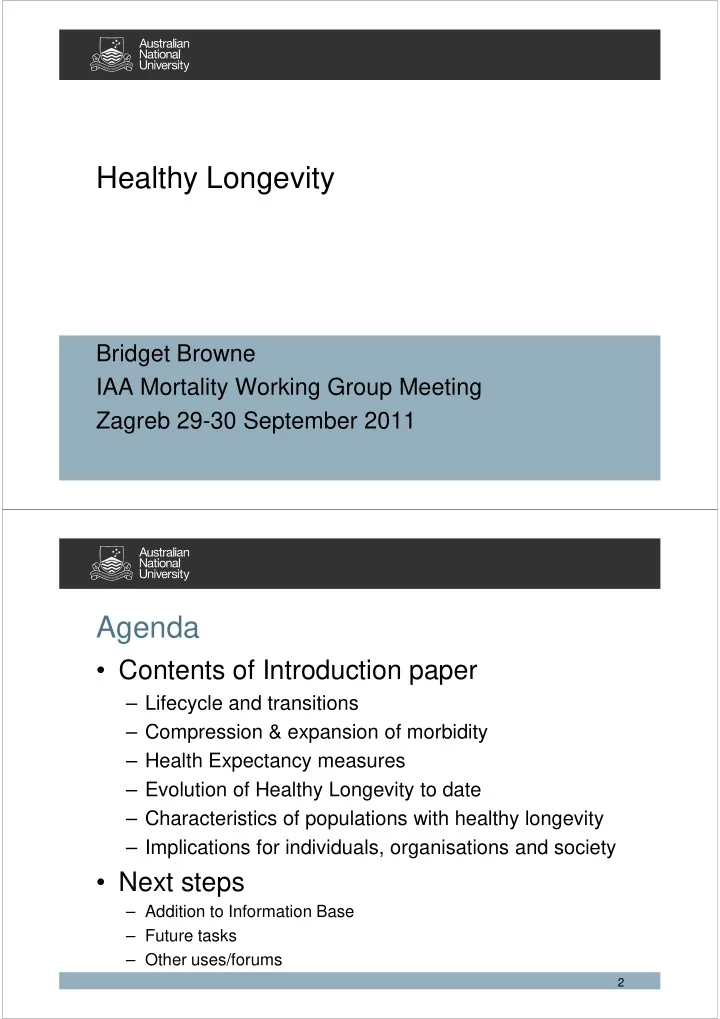

Healthy Longevity Bridget Browne IAA Mortality Working Group Meeting Zagreb 29-30 September 2011 Agenda • Contents of Introduction paper – Lifecycle and transitions – Compression & expansion of morbidity – Health Expectancy measures – Health Expectancy measures – Evolution of Healthy Longevity to date – Characteristics of populations with healthy longevity – Implications for individuals, organisations and society • Next steps – Addition to Information Base – Future tasks – Other uses/forums 2
Lifecycle and transitions • Complexity of definitions • Model of disablement process Extra Individual Factors Pathology Impairments Functional Limitations Disability Risk Factors Intra Individual Factors Source: Verbrugge and Jette 3 Compression & Expansion of Morbidity Compression of morbidity : Initially proposed ( Fries , 1980) under the • assumption that life expectancy was approaching a maximum limit, the hypothesis was that medical progress and improved health behaviours would then effectively serve to increase the proportion and quantum lifetime spent in good health, compressing the time spent in a disabled state further towards the end of life end of life Expansion of morbidity : Others hypothesised that medical progress would • have the opposite effect: extending the lifespan of a much broader spectrum of the population, thus increasing the survival of the frail elderly and leading to more years lived in poor health on average. ( Gruenberg , 1977) characterised this rather expressively as the “failures of success”. Olshansky was amongst this group, but as we shall see later, is currently much more optimistic about the prospects for influencing healthy longevity. Equilibrium between longevity and health: ( Manton , 1982) then proposed a • dynamic equilibrium where progress is made in prolonging both total and healthy lifespan, leading to approximately stability in the ratio of healthy to total lifespan. 4
Compression & Expansion of Morbidity Definitions: Compression Expansion Absolute Dependent LE Years decrease Dependent LE Years increase Relative Dependent LE as a % of Total LE Dependent LE as a % of Total LE decreases increases Example: Total LE Healthy LE Dependent LE Dependent LE as % of Total LE Current 25 20 5 20% Absolute expansion and 28 21 7 25% relative expansion Absolute is constant with 28 23 5 18% relative compression Absolute compression and 28 25 3 11% relative compression 5 Health Expectancy Measures Details Measure From a given age. May be projected, but in this field is nearly universally a Life Expectancy (LE) or Total Life period-based measure Expectancy (TLE) Disease Free Life Expectancy or An example is the European Union structural indicator Health Life Years (HLY) which is based on limitations in daily activities. Dementia-free Life Expectancy is Disability Free Life Expectancy an example of a DisFLE for a specific condition. (DFLE or DisFLE) Health Expectancy or Healthy Life Health Expectancy or Healthy Life Can be based on self-rated health information such as responses to “How is your Can be based on self-rated health information such as responses to “How is your health in general?” Expectancy (HLE) The DALY measures health gaps as opposed to health expectancies, it can be Disability Adjusted Life Year (DALY) thought of as one lost year of “healthy” life. It measures the difference between a current situation and an ideal situation where everyone lives up to the age of the standard life expectancy, and in perfect health. DALY = YLL (Yrs of Life Lost due to premature mort’y) + YLD (Ys Lived w Dis’y). The YLL metric essentially corresponds to the number of deaths multiplied by a fixed standard life expectancy at the age at which death occurs. Developed by WHO for the Global Burden of Disease Study The QALY measure is used most frequently in assessing the value for money of Quality Adjusted Life Years (QALY) medical interventions, by estimating the quantity of additional life lived adjusted for the quality of the health status. The amount of time spent in a health state is weighted by the utility score given to that health state. 6
Using Survival Curves Source: WHO 1984 7 Health Expectancy Measures • Sullivan method: uses period mortality incidences and disability (however defined) prevalences • EHEMU provides User Guide and spreadsheet • Longitudinal or multi-state or transition probability based models are more accurate but much more data intensive 8
Evolution of Healthy Longevity to date • Results are mixed • One theme, identified by Robine, is that countries with relatively low e65 are countries with relatively low e65 are experiencing improving HLE, whereas those with longest e65 are not • Many confounding factors 9 Characteristics of Populations with Healthy Longevity (Buettner 2008) • Physical activity: – Moving – constant moderate physical activity is integrated into daily life via walking, climbing stairs or gardening. • Diet related: – Smaller meals in general, smallest in the late afternoon or early evening – Smaller meals in general, smallest in the late afternoon or early evening – Avoidance of meat. Preference for legumes and nuts with focus on best quality lean meat. – Regular light alcohol consumption and no smoking. • Social engagement: – Avoidance of stress – Prioritisation of family – especially living in an extended family unit – A sense of belonging – to a faith-based community and also to a social group with a positive outlook. A sense of purpose . 10
Implications for Individuals, Organisations and Society • Individuals – Change in length and extent of workforce participation? – Changes in environment to minimise functional disability • Organisations • Organisations – Insurance companies, Health care providers – Public sector • Society – Focus on disability reduction rather than mortality reduction? – Focus on reducing socio-economic differences? 11 Resources • EHEMU: http://www.ehemu.eu/ • REVES network: • REVES network: http://reves.site.ined.fr/en/ • AXA Global Forum on Longevity: http://longevity.axa.com/en/ 12
Next Steps • Addition to Information Base • Future tasks • Other uses/forums • Other uses/forums 13
Recommend
More recommend